Introduction

Nail foils are a popular trend in the world of nail art, allowing you to create stunning designs and add a touch of glamour to your manicure. Whether you’re a beginner or a seasoned nail enthusiast, learning how to use nail foils can elevate your nail game to the next level. In this article, we will explore what nail foils are, the benefits of using them, and provide step-by-step instructions on how to apply them. Get ready to experiment with different techniques and unleash your creativity with nail foils.
1 What Is Nail Foil?
Nail foil is a thin, metallic or holographic material that is used to create intricate designs and patterns on the nails. It is typically available in sheet form, with various colors, finishes, and patterns to choose from. Nail foil is made of a special adhesive backing that allows it to adhere to the nails when applied correctly. When applied, the foil adds a stunning, reflective effect to the nails, giving them a unique and eye-catching look. Nail foils are a popular choice for nail art enthusiasts due to their versatility and ability to create intricate designs with ease.
2 Benefits Of Using Nail Foil
Using nail foil for your manicures offers several benefits that make it a popular choice among nail art enthusiasts. Here are two key benefits of using nail foil:
- Versatility: Nail foils come in a wide range of colors, finishes, and patterns, allowing you to create endless possibilities for your nail designs. You can experiment with different combinations, mix and match foil patterns, and create unique looks that reflect your personal style.
- Eye-catching Effect: Nail foil adds a stunning, reflective effect to the nails, making them stand out and catch the light. The metallic or holographic finish adds depth and dimension to your nail art, giving it a captivating and luxurious appearance.
With these benefits, using nail foil can elevate your nail art game and give you professional-looking results. So, embrace your creativity and have fun experimenting with nail foils!
Preparation
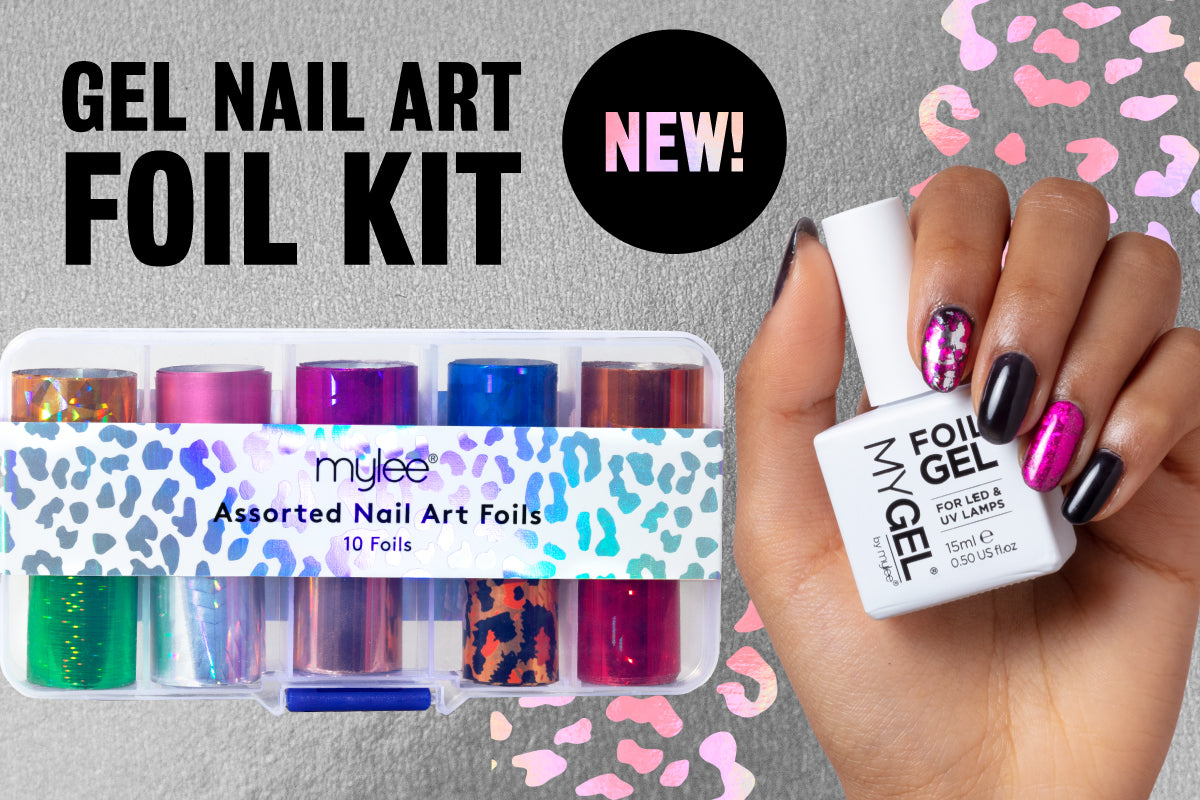
Before applying nail foil, it is important to properly prepare your nails to ensure a smooth and long-lasting application. Start by gathering all the necessary materials, such as nail foils, base coat, nail polish, top coat, nail foil adhesive, an orange stick, and a UV or LED lamp. Once you have your materials ready, prepare your nails by pushing back the cuticles, trimming any excess cuticle, and buffing the surface of the nails. This will create a clean and even base for the nail foil application. Remember to choose a color combination or pattern that you want to achieve with the nail foils.
1 Gather Your Materials
To use nail foil, it’s important to gather all the necessary materials beforehand. You will need nail foils, base coat, nail polish, top coat, nail foil adhesive, an orange stick, and a UV or LED lamp. Having all these materials ready will ensure a smooth application process. Additionally, remember to choose the color combination or pattern you want to achieve with the nail foils. Being prepared with all the materials will make your nail foil application much easier and more successful.
2 Preparing Your Nails For Nail Foil Application
Preparing your nails for nail foil application is an essential step to ensure a smooth and long-lasting result. Start by removing any existing nail polish using a non-acetone nail polish remover. Trim and shape your nails to your desired length and shape. Gently push back your cuticles using an orange stick or a cuticle pusher. It’s important to have clean and oil-free nails before applying the nail foil adhesive. Finish off by buffing your nails lightly to create a smooth surface. This will help the nail foil adhere better to your nails.
Nail Foil Application Techniques
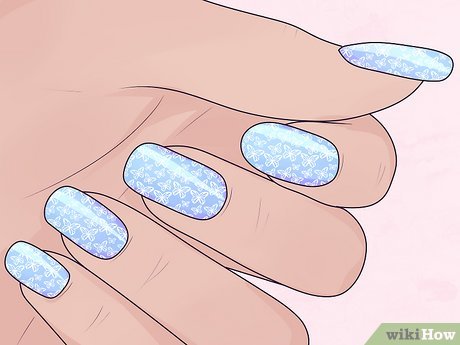
When it comes to applying nail foils, there are two main techniques that you can use. The first technique is a full nail foil application, where you cover the entire nail with the foil design. This technique is great for creating bold and eye-catching looks. The second technique is a partial nail foil application, where you place the foil in specific spots on the nail. This technique allows for more versatility and creativity in your nail designs. Whichever technique you choose, make sure to press the foil firmly onto the nail and smooth out any wrinkles or air bubbles for a seamless finish.
1 Technique 1: Full Nail Foil Application
To achieve a bold and eye-catching look, one technique for applying nail foils is the full nail foil application. Start by applying a base coat of polish and allowing it to dry. Then, cut a piece of foil that is slightly larger than your nail. Apply a foil adhesive or nail foil glue to the nail and let it dry until it becomes tacky. Place the foil on the nail, shiny side up, and press it firmly. Gently peel off the foil to reveal a stunning, full nail foil design. Remember to seal the design with a top coat for long-lasting wear.
2 Technique 2: Partial Nail Foil Application
To create a more subtle and intricate nail foil design, you can opt for partial nail foil application. Start by painting your nails with a base coat and allowing it to dry. Cut a piece of foil that is slightly larger than the area you want to cover on your nail. Apply a nail foil adhesive or glue to the desired area and let it dry until it becomes tacky. Place the foil on the adhesive, shiny side facing up, and press it firmly. Then, gently peel off the foil to reveal your partial nail foil design. Finish off with a top coat to seal the design and enhance its longevity. By using this technique, you can create unique and stylish nail art that is sure to impress.
Accent Nails
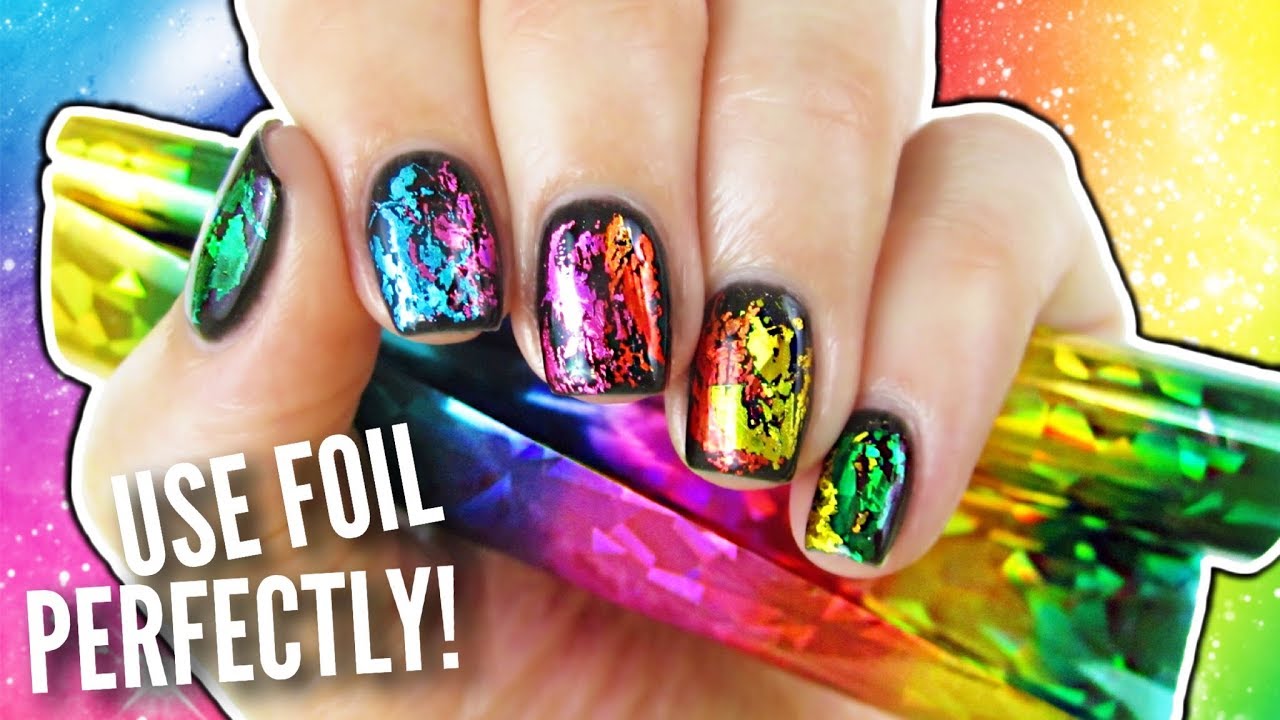
Accent nails are a popular trend in the world of nail art. They involve choosing one or two nails to create a unique design or use a different color from the rest of the nails. When using nail foil, accent nails can be a great way to showcase a stunning foil design or create contrast with other nail art techniques. By incorporating accent nails into your manicure, you can add an extra touch of creativity and make your nails truly stand out.
Creating Nail Art With Nail Foil
Creating nail art with nail foil is a fun and creative way to elevate your manicure. There are several techniques you can use to incorporate foil into your nail designs. One popular method is using nail foil with nail polish designs. Simply apply your desired nail polish color as a base, let it dry, then apply a thin layer of foil glue or adhesive. Press the foil onto the nail, gently rubbing it to transfer the design. Another option is using nail foil with nail stamping designs. After stamping your desired design onto your nail, apply foil glue to the stamped area and then press the nail foil onto it. This will give your stamping design a beautiful and shimmery effect. With nail foil, the possibilities are endless for creating unique and eye-catching nail art designs.
1 Using Nail Foil With Nail Polish Designs
To create stunning nail art with nail foil, you can incorporate it into your nail polish designs. Start by applying your desired nail polish color as a base and allowing it to dry completely. Then, apply a thin layer of foil glue or adhesive onto your nails. Next, press the nail foil sheet onto the nail, gently rubbing it to transfer the design. This technique will add a beautiful and shimmery effect to your nail polish designs and take your manicure to the next level.
2 Using Nail Foil With Nail Stamping Designs
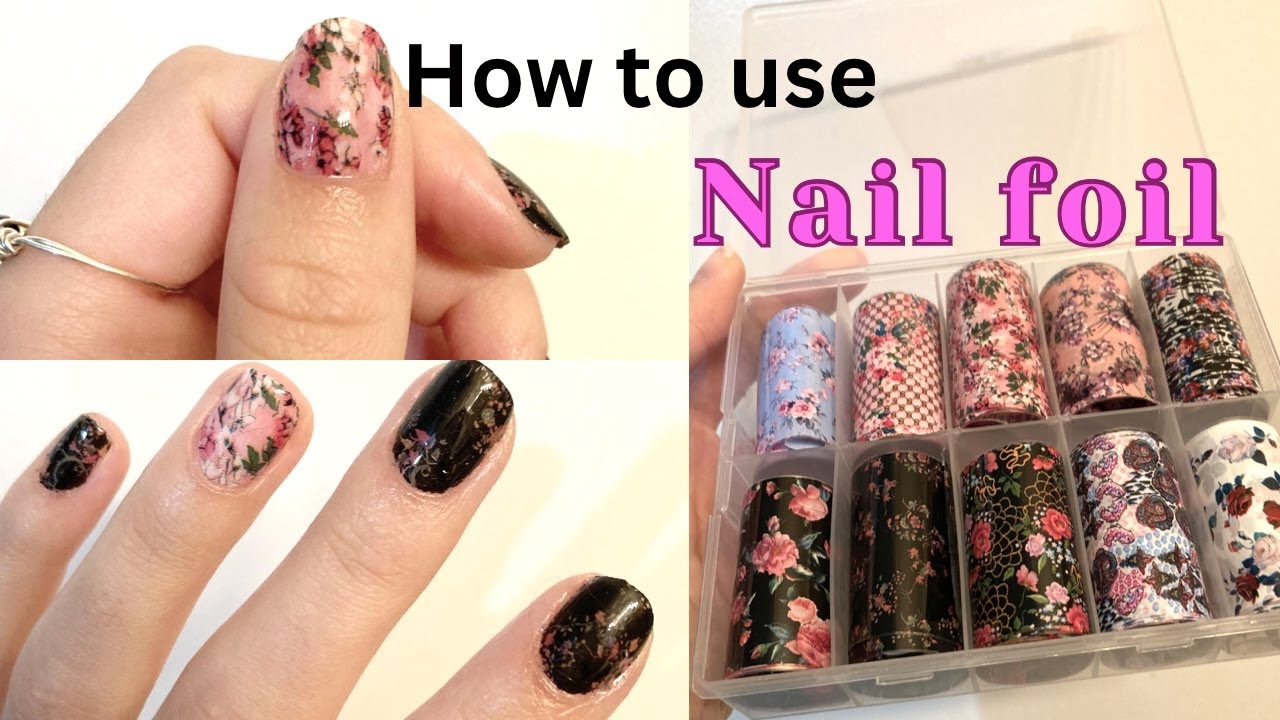
Nail stamping is another popular nail art technique that can be enhanced with the use of nail foil. After stamping a design onto your nails using a nail stamping plate and stamper, you can add an extra level of dimension and shine by applying nail foil over the stamped design. Simply apply a thin layer of foil glue or adhesive over the stamped design and press the nail foil onto the nails, gently rubbing it to transfer the foil onto the design. This will create a stunning and eye-catching metallic effect on your nail stamping designs.
Nail Foil Removal And Maintenance
To remove nail foil, you can use a nail polish remover that contains acetone. Simply soak a cotton pad in the remover and place it on top of the foil. Wrap each finger with aluminum foil and let it sit for about 10-15 minutes. After that, gently remove the foil and wipe off any remaining foil with a clean cotton pad. To maintain your nail foil designs, it is recommended to apply a top coat over the foil to protect and seal the design, preventing it from chipping or fading.
1 Safely Removing Nail Foil
To safely remove nail foil, it is recommended to use a nail polish remover that contains acetone. Begin by soaking a cotton pad in the remover and placing it on top of the foil. Wrap each finger with aluminum foil and let it sit for about 10-15 minutes. This allows the acetone to break down the adhesive on the foil. Gently remove the foil and wipe off any remaining foil with a clean cotton pad. Don’t forget to moisturize your nails and cuticles after removing the foil. Remember to always handle acetone-based products in a well-ventilated area to avoid inhalation.
2 Maintaining Nail Foil Designs
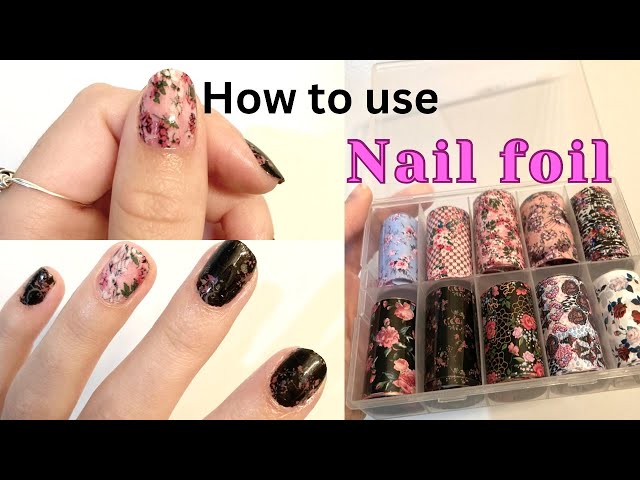
Maintaining nail foil designs is important in order to prolong their longevity and keep them looking fresh. Here are some tips for maintaining nail foil designs:
- Avoid exposing your nails to excessive water or moisture, as this can cause the foil to lift or peel.
- Use a top coat to seal and protect the foil design. This will help to prevent chipping and extend the life of the design.
- Be gentle when doing activities that may put strain on your nails, such as typing or opening containers, as excessive pressure can damage the foil.
- In case of any minor lifting or peeling, you can carefully trim or file away the damaged foil and apply a new layer of top coat to maintain the design.
Following these maintenance tips will help keep your nail foil designs looking vibrant and eye-catching for longer periods of time.
Conclusion
In conclusion, nail foil is a versatile and trendy nail art technique that allows individuals to create stunning and unique designs on their nails. Throughout this post, various aspects of nail foil have been explored, including what it is, how to apply it, its benefits, compatibility with gel polish, longevity, removal process, potential damage to natural nails, and where to buy it. By following the proper application and removal techniques, the potential risks associated with nail foils can be minimized. Nail foil offers endless creative possibilities for those who want to express themselves through their nail art.
1 Tips And Tricks For Successful Nail Foil Application
When it comes to successful nail foil application, there are a few tips and tricks that can help you achieve the best results. Here are some recommendations to keep in mind:
- Ensure your nails are clean and properly prepped before applying the foil.
- Use a good adhesive or gel polish base coat specifically designed for nail foils.
- Cut the foil into smaller pieces for more precise application.
- Gently press the foil onto the nail, making sure to smooth out any wrinkles or air bubbles.
- Use a soft brush or cotton swab to remove any excess foil around the edges of the nail.
- Seal the foil design with a top coat to protect the design and enhance its longevity.
By following these tips and tricks, you can achieve stunning and long-lasting nail foil designs.
Frequently Asked Questions about Using Nail Polish Remover to Remove Paint
Q: Can nail polish remover effectively remove paint?
A: Nail polish remover is not specifically designed to remove paint, but it can be used as a solution to remove certain types of paint. However, its effectiveness may vary depending on the type of paint and the surface you are working with.
Q: What types of paint can nail polish remover remove?
A: Nail polish remover is most effective at removing enamel or acrylic paint from non-porous surfaces, such as glass, metal, or plastic. It may not be as effective on porous surfaces like wood or fabric.
Q: How does nail polish remover remove paint?
A: Nail polish removers typically contain a solvent called acetone, which acts as a paint thinner. Acetone breaks down the chemicals in the paint, making it easier to remove. However, certain types of paint, such as oil-based paints, may require a stronger solvent or a different method of removal.
Q: How should I use nail polish remover to remove paint?
A: Start by applying a small amount of nail polish remover to a clean cloth or cotton ball. Gently rub the painted area in a circular motion, applying slight pressure. If the paint starts to dissolve, continue rubbing until it is fully removed. Be cautious not to oversaturate the surface or use excessive force to avoid damaging it.
Q: Are there any precautions I should take when using nail polish remover to remove paint?
A: Yes, there are a few precautions to consider. Before using nail polish remover, test it on a small, inconspicuous area to ensure it does not cause damage or discoloration. Make sure to work in a well-ventilated area to avoid inhaling the fumes. Wear protective gloves to protect your hands from potential irritation, and avoid contact with your eyes. Additionally, keep in mind that nail polish remover may not effectively remove all types of paint or stains.
Q: What should I do if nail polish remover doesn’t work to remove the paint?
A: If nail polish remover is ineffective at removing the paint, it is best to try alternative methods or consult a professional. You can consider using stronger solvents specifically designed for paint removal, or you may need to resort to scraping or sanding the paint off the surface, depending on the material.
Q: Is there any risk of damaging the surface when using nail polish remover?
A: Nail polish remover, particularly acetone-based ones, has the potential to damage certain surfaces. It is important to use caution and test the remover on a small area before applying it to the entire painted surface. Delicate or easily damaged materials, such as certain plastics or finished wood, may be more susceptible to damage.
Q: Can nail polish remover remove paint from clothing or fabric?
A: While nail polish remover may be effective at removing paint from non-porous surfaces, it is not recommended for use on clothing or fabric. Acetone can damage delicate fabrics and may cause discoloration. It is advisable to consult a professional cleaner or use alternative methods for removing paint from clothes or fabrics.
Q: Are there any alternatives to using nail polish remover for paint removal?
A: Yes, there are alternative methods for removing paint, depending on the surface and type of paint. Some alternatives include using paint strippers, heat guns, sanding, scraping, or seeking professional assistance. It is best to research the appropriate methods and precautions for your specific paint removal needs, especially for delicate or valuable surfaces.

I am proud to offer non-toxic beauty options. The gel polishes I offer are “9-Free”, free of nine of the most commonly found allergens and toxic chemicals in nail polish, and cruelty-free, vegan, and HEMA-free. The nail lacquers I offer range between “7-Free” and “16+-Free” and are also cruelty-free and vegan.